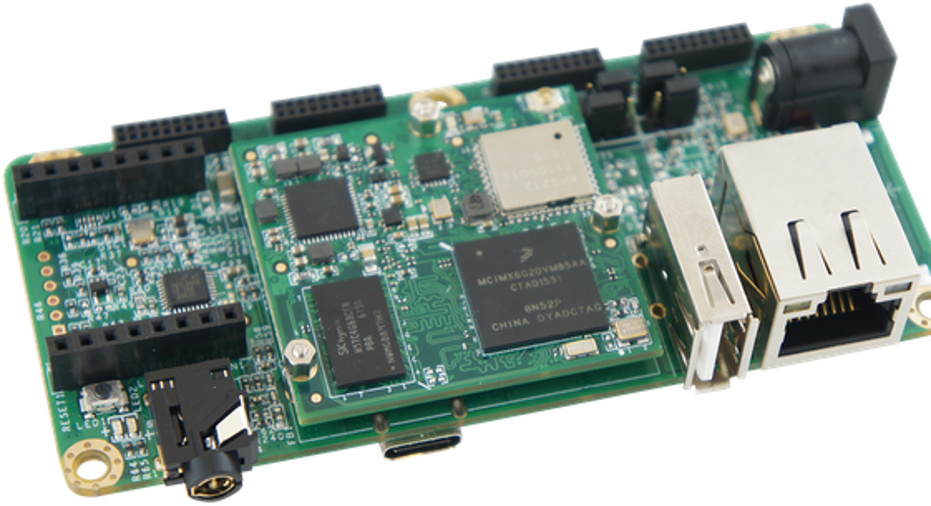Will Alphabet's New Internet of Things Platform Be a Boon For NXP Semiconductors and Intel?

The NXP PICO platform for Android Things, up close and personal. Image source: NXP.
Alphabet's (NASDAQ: GOOG) (NASDAQ: GOOGL) Google division has released a slew of specialized Android versions. This week, the Android Things platform for devices under the Internet of Things umbrella made its first appearance. Investors in the semiconductor sector should pay attention, especially those who own shares of launch partners NXP Semiconductors (NASDAQ: NXPI), Intel (NASDAQ: INTC), and Broadcom (NASDAQ: AVGO).
What's new?
Android Things started life under the code name "Brillo" back in the spring of 2015. From the start, this platform was designed to support sophisticated sensors and efficient wireless networking, all while requiring extremely low amounts of memory space and electric power. The Brillo project has now grown up, launching into an Android-branded market presence and a handful of Google-approved hardware systems.
The first Android Things developer kits come from Broadcom (under the Raspberry Pi brand), Intel, and NXP. Google has vetted five specific system-on-a-module packages to work with the launch version of Android Things, and it will stand behind those hardware-software combinations with support services and officially approved plug-in attachments.
These platforms are expected to form the core of actual IoT products running the Android Things software. Given Google's massive presence in the online business world, including Android's global domination of the smartphone market, this development channel seems likely to gain traction quickly. Being aboard the initial launch hardware should lead to large volumes of IoT chip sales as this platform matures.
The contenders
The five launch-date platforms cover a lot of ground.
For example, the Intel Edison module cuts every corner it can. It has a slow dual-core Intel Atom processor, only supports limited amounts of RAM and permanent storage, and doesn't even come with a graphics processing unit. This is the one you'd want for a no-frills IoT device where low cost and minimal power consumption are the primary design goals.
But Android Things also supports the high-end Intel Joule module. Armed with about six times the processing power of an Edison module, the latest and greatest WiFi technology, and a decent graphics chip to boot, this one would be a better choice for advanced processing tasks or a screen-equipped service kiosk.
The Joule development board is available now for $337 per kit. An Edison kit will run you $48 today. These products are aimed at very different target markets and are priced accordingly.
NXP takes the middle ground between Intel's extreme high-end and low-end options. The Argon and Pico boards come with the same NXP i.MX6UL processor, with similar mid-range amounts of memory and support for technology standards. The Pico costs a little bit more and comes with a couple of additional networking features. These boards cost roughly $60 apieceand fit comfortably into a potential mainstream space between Intel's radical outliers. NXP is aiming these boards at decidedly mid-range applications such as locks, thermostats, temperature sensors, and lighting systems.
Finally, the Broadcom-powered Raspberry Pi 3 has been available to consumers since February, 2016. The board packs a respectable processing punch for just $42, but it's currently out of stock. The Google Things launch may have overwhelmed the Raspberry Pi supply chain temporarily -- a good sign for the long-term value of these hardware and software platforms.
Image source: Getty Images.
What's next?
This is just an early salvo in a long war. Android Things does have the deck stacked in its favor, but it still must execute over the long haul in order to make a difference.
The Android brand and the years of network security work that have gone into it will help, and some of the biggest semiconductor hardware suppliers are already involved. These are positive signs for the platform's long-term survival.
On the other hand, Android Things is far from first out of the gate. Name a large technology business, and chances are that your pick is testing the waters with its own IoT platform. You could even argue that Google is late to the party. That's not good.
So, there's is a lot of work left to do before crowning any winners. In the end, the IoT market is easily large enough to support several major platforms, each one burrowing into a specific niche.
10 stocks we like better than NXP Semiconductors When investing geniuses David and Tom Gardner have a stock tip, it can pay to listen. After all, the newsletter they have run for over a decade, Motley Fool Stock Advisor, has tripled the market.*
David and Tom just revealed what they believe are the 10 best stocks for investors to buy right now...and NXP Semiconductors wasn't one of them! That's right -- they think these 10 stocks are even better buys.
Click here to learn about these picks!
*Stock Advisor returns as of Nov. 7, 2016.
Anders Bylund owns shares of Intel and A shares of Alphabet. The Motley Fool owns shares of and recommends Alphabet (A and C shares). The Fool also recommends Broadcom, Intel, and NXP Semiconductors. Suzanne Frey, an executive at Alphabet, is a member of The Motley Fool's board of directors. Try any of our Foolish newsletter services free for 30 days.
We Fools may not all hold the same opinions, but we all believe that considering a diverse range of insights makes us better investors. The Motley Fool has a disclosure policy.